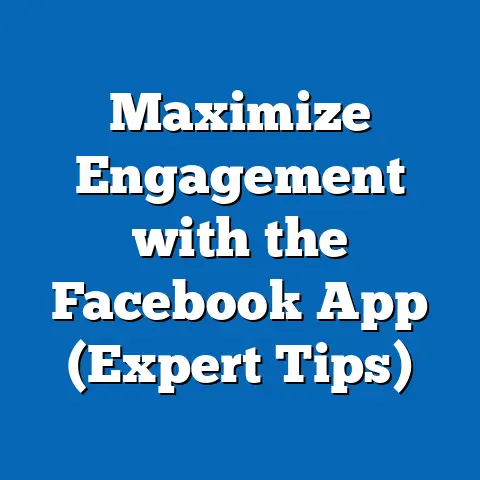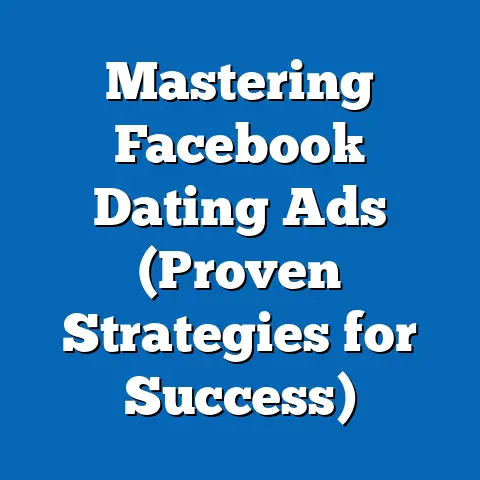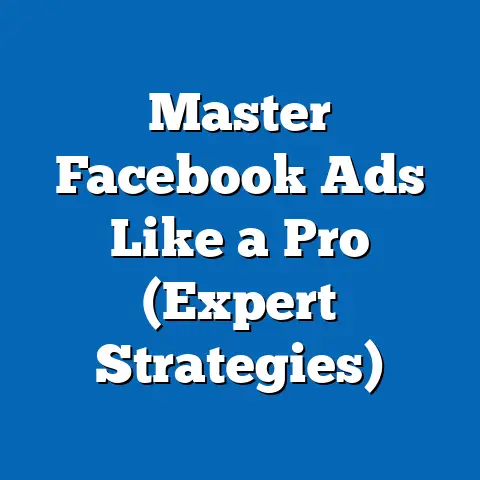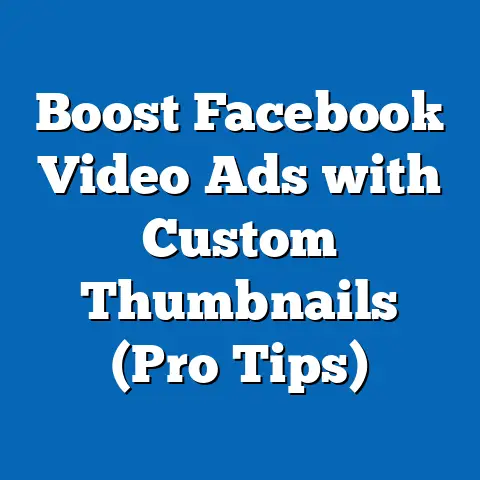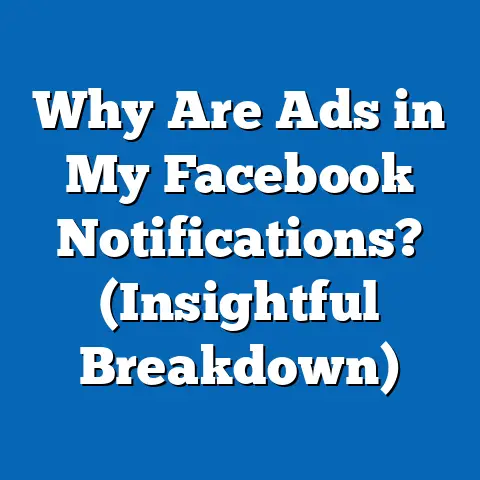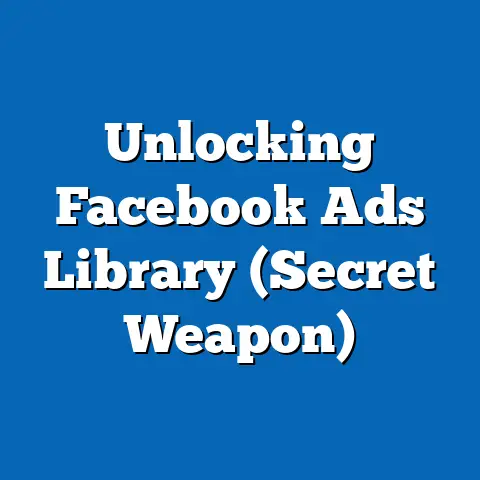Navigate Facebook Ad Break Requirements (Must-Know Guidelines)
Social media advertising is a constantly evolving beast. One day you’re riding high on a particular strategy, the next you’re scrambling to adjust to a platform update. Staying compliant with platform guidelines isn’t just about avoiding penalties; it’s about maximizing your ROI and building a sustainable presence. Facebook Ad Breaks, when used correctly, are a fantastic monetization tool. They allow content creators to generate revenue from their videos, while simultaneously providing advertisers with valuable opportunities to reach engaged audiences. This guide will walk you through everything you need to know, from the basics to the more nuanced aspects, so you can confidently leverage Ad Breaks to their full potential.
Understanding Facebook Ad Breaks
So, what exactly are Facebook Ad Breaks? In simple terms, they’re short video ads that play during natural pauses in longer Facebook videos. Think of them like commercial breaks on television, but tailored for the digital age. For content creators, Ad Breaks offer a way to monetize their video content. Instead of relying solely on sponsorships or merchandise sales, they can earn revenue based on the number of ad impressions their videos generate.
The advantages of using Ad Breaks are numerous, especially for content creators. First and foremost, it’s a revenue stream. The more engaging your content and the more viewers you attract, the more you can potentially earn. Secondly, it can boost audience engagement. Well-placed Ad Breaks, that don’t interrupt the flow of the video, can actually enhance the viewing experience. They give viewers a brief pause, allowing them to process what they’ve seen and prepare for the next segment.
I remember when Ad Breaks first rolled out, there was a lot of skepticism. Creators were worried about alienating their audience, and advertisers were unsure if the format would be effective. But over time, as Facebook refined the algorithm and creators learned how to strategically place ads, Ad Breaks became a valuable tool for everyone involved.
From a broader perspective, Ad Breaks fit into Facebook’s overall monetization strategy. Facebook wants to incentivize creators to produce high-quality content and keep users engaged on the platform. By providing tools like Ad Breaks, Facebook creates a win-win situation. Creators are rewarded for their efforts, advertisers can reach targeted audiences, and Facebook benefits from increased user activity.
For businesses and brands, the benefits are equally compelling. Ad Breaks offer a unique opportunity to reach a highly engaged audience within a specific context. Unlike traditional display ads, which can be easily ignored, Ad Breaks are integrated into the video viewing experience. This means viewers are more likely to pay attention, especially if the ad is relevant to their interests.
Takeaway: Facebook Ad Breaks are short video ads that play during longer Facebook videos, offering a monetization opportunity for creators and a targeted advertising channel for businesses.
Eligibility Requirements
Okay, so you’re interested in using Facebook Ad Breaks. Great! But before you start planning your video empire, it’s important to understand the eligibility requirements. Facebook has specific criteria that creators and advertisers must meet in order to participate.
One of the most important factors is the minimum follower count. While the exact number can vary depending on your location and the specific type of content you create, you generally need to have at least 10,000 followers on your Facebook Page. This requirement ensures that you have a substantial audience and that your videos are likely to generate a significant number of ad impressions.
Video length is another critical consideration. Your videos typically need to be at least three minutes long to be eligible for Ad Breaks. This requirement is in place because shorter videos don’t provide enough opportunities to insert ads without disrupting the viewing experience. Think about it: a 30-second ad in a one-minute video would be incredibly intrusive.
Content guidelines are also paramount. Facebook has strict rules about the type of content that can be monetized with Ad Breaks. You need to ensure that your videos are original, family-friendly, and comply with Facebook’s advertising policies.
I’ve seen creators get tripped up by the content guidelines more than anything else. They might accidentally use copyrighted music or include content that’s deemed inappropriate. It’s crucial to thoroughly review Facebook’s policies before you start creating videos for Ad Breaks.
Geographical restrictions can also come into play. Ad Breaks are not available in every country. Facebook is gradually expanding the program to more regions, but it’s important to check if your location is supported.
What types of content qualify for Ad Breaks? Generally, videos that are engaging, informative, and entertaining tend to perform well. Some popular niches include:
- Educational content: Tutorials, how-to videos, and documentaries.
- Entertainment: Comedy sketches, short films, and music videos.
- Lifestyle: Travel vlogs, cooking shows, and fashion tips.
However, certain niches are particularly well-suited for Ad Breaks. For example, educational content often attracts a highly engaged audience that’s willing to watch longer videos. Similarly, entertainment content can generate a lot of views, which translates into more ad impressions.
Takeaway: To be eligible for Facebook Ad Breaks, you typically need at least 10,000 followers, videos that are at least three minutes long, compliant content, and be located in an eligible region.
Content Guidelines
Let’s delve deeper into the content guidelines that creators must adhere to. This is where things can get a little tricky, so it’s important to pay close attention.
Original content is the name of the game. Facebook is very strict about copyright infringement. If you use copyrighted music, video clips, or other materials without permission, your videos will likely be demonetized. It’s always best to create your own content or use royalty-free resources.
I once worked with a creator who unknowingly used a snippet of a popular song in one of their videos. They were surprised when their video was flagged for copyright infringement, even though the song was only playing in the background for a few seconds. It’s a good reminder that even small details can have a big impact.
Restrictions on certain types of content are also crucial. Facebook prohibits content that promotes violence, hate speech, or misinformation. This includes content that attacks individuals or groups based on their race, ethnicity, religion, gender, or sexual orientation. It also includes content that spreads false or misleading information about important topics like health or politics.
The implications of violating these guidelines can be severe. Your videos could be demonetized, your Page could be suspended, or even your account could be permanently banned. It’s simply not worth the risk.
So, what are some best practices for creating engaging and compliant content? Here are a few tips:
- Know your audience: Understand what they’re interested in and create videos that resonate with them.
- Be authentic: Let your personality shine through and connect with your viewers on a personal level.
- Provide value: Offer useful information, entertainment, or inspiration.
- Stay informed: Keep up-to-date with Facebook’s advertising policies and content guidelines.
- Engage with your community: Respond to comments, answer questions, and build relationships with your viewers.
Remember, the goal is to create videos that people want to watch and share. If you focus on providing value and building a loyal audience, you’ll be well on your way to success with Facebook Ad Breaks.
Takeaway: Adhere to Facebook’s strict content guidelines, focusing on original, family-friendly content that avoids violence, hate speech, and misinformation.
Technical Requirements
Now, let’s talk about the technical side of things. Facebook Ad Breaks have specific technical requirements that you need to follow in order to ensure that your videos are properly monetized.
Video format is one of the most important considerations. Facebook supports a variety of video formats, including MP4, MOV, and AVI. However, MP4 is generally the preferred format because it’s widely compatible and offers good compression.
Resolution is another key factor. Facebook recommends that your videos have a resolution of at least 720p (1280×720 pixels). Higher resolutions, like 1080p (1920×1080 pixels) or 4K (3840×2160 pixels), can also be used, but they’ll require more bandwidth and storage space.
Video length, as we discussed earlier, is also important. Your videos need to be at least three minutes long to be eligible for Ad Breaks. However, longer videos tend to perform better because they provide more opportunities to insert ads.
Setting up Ad Breaks within the Facebook Creator Studio is relatively straightforward. Here’s a step-by-step guide:
- Go to Creator Studio: Navigate to the Creator Studio on Facebook.
- Upload your video: Click on the “Create Post” button and upload your video.
- Add details: Add a title, description, and tags to your video.
- Enable monetization: In the “Monetization” tab, enable Ad Breaks.
- Choose ad placements: Select where you want the Ad Breaks to appear in your video. You can choose automatic placements or manually insert them at specific points.
- Submit for review: Once you’re satisfied with your settings, submit your video for review.
Monitoring performance metrics is essential for optimizing your Ad Break strategy. Facebook provides a variety of metrics that you can use to track your earnings, ad impressions, and audience engagement.
Some key metrics to watch include:
- RPM (Revenue per Mille): The amount of money you earn for every 1,000 ad impressions.
- Ad impressions: The number of times your ads are shown to viewers.
- View duration: The average amount of time viewers spend watching your videos.
- Audience retention: The percentage of viewers who watch your videos all the way through.
By tracking these metrics, you can identify what’s working and what’s not. You can then adjust your content strategy, ad placements, and other settings to improve your performance.
Takeaway: Ensure your videos meet Facebook’s technical specifications, including format, resolution, and length. Use the Creator Studio to set up Ad Breaks and monitor performance metrics for optimization.
Common Pitfalls and How to Avoid Them
Even with a clear understanding of Facebook Ad Break requirements, it’s easy to make mistakes. Let’s take a look at some common pitfalls and how to avoid them.
One common mistake is using copyrighted material without permission. As we discussed earlier, Facebook is very strict about copyright infringement. To avoid this pitfall, always create your own content or use royalty-free resources. There are many websites that offer free or low-cost stock music, video clips, and images.
Another common mistake is violating Facebook’s content guidelines. This includes posting content that promotes violence, hate speech, or misinformation. To avoid this pitfall, carefully review Facebook’s advertising policies and content guidelines before you start creating videos.
Failing to optimize your ad placements is another common mistake. If your Ad Breaks are poorly placed, they can disrupt the viewing experience and annoy your audience. To avoid this pitfall, experiment with different ad placements and monitor your performance metrics. Pay attention to where viewers are dropping off and adjust your ad placements accordingly.
I’ve seen creators make the mistake of placing too many ads in their videos. While it’s tempting to maximize your revenue, overloading your videos with ads can actually backfire. Viewers may become frustrated and stop watching your content altogether.
To avoid this pitfall, be strategic about your ad placements. Focus on providing value to your audience and inserting ads in natural pauses in your videos.
Staying updated with Facebook’s evolving policies and guidelines is also crucial. Facebook is constantly updating its rules and regulations, so it’s important to stay informed.
To avoid this pitfall, regularly check Facebook’s advertising policies and content guidelines. You can also sign up for Facebook’s developer newsletter to receive updates about new features and changes.
The potential consequences of failing to comply with Ad Break requirements can be severe. Your videos could be demonetized, your Page could be suspended, or even your account could be permanently banned. It’s simply not worth the risk.
Takeaway: Avoid common mistakes like using copyrighted material, violating content guidelines, and failing to optimize ad placements. Stay updated with Facebook’s evolving policies to prevent demonetization or account suspension.
Conclusion
Navigating Facebook Ad Break requirements might seem daunting at first, but it’s an essential skill for anyone looking to maximize their long-term savings and revenue in the digital marketing landscape. By understanding the eligibility criteria, content guidelines, technical requirements, and common pitfalls, you can position yourself for success in the ever-competitive world of social media advertising.
Remember, the key is to create high-quality, engaging content that complies with Facebook’s policies. By providing value to your audience and building a loyal community, you can generate significant revenue from Ad Breaks while also building a sustainable presence on the platform.
I encourage you to take proactive steps in your digital marketing strategy by adhering to these guidelines. Stay informed, experiment with different approaches, and track your results. With a little effort and dedication, you can master Facebook Ad Breaks and unlock a new level of success in your online endeavors. Good luck!

